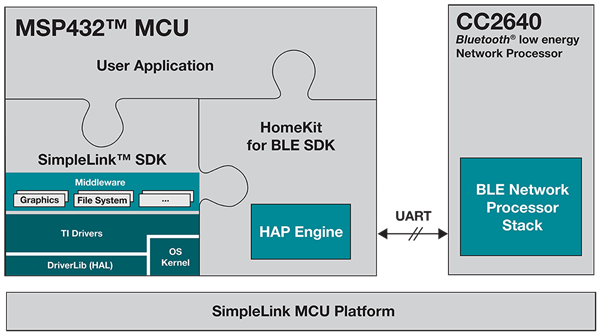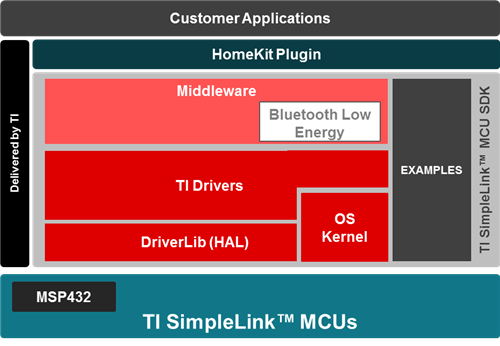SSZTAD4 march 2017 CC2640 , CC2650 , CC2650MODA
Home automation has grown tremendously in recent years thanks to the accessibility of wireless technologies and – more importantly – the standardization of previously diverging standards and protocols. One standardization effort is Apple’s HomeKit technology, a framework that defines a common protocol and environment where HomeKit enabled systems work by the same rules, ensuring device interoperability.
HomeKit technology’s level playing field enables you to worry less about the framework and gain valuable time to spend making your end products stand out from competition. Taking it a step further, TI’s Bluetooth® low energy HomeKit solution features the MSP432™ host microcontroller (MCU) and SimpleLink™ CC2640 Bluetooth low energy wireless MCU in wireless network processor (WNP) mode (Figure 1), delivering both a HomeKit enabled solution and tons of highly differentiated features to help you set your products apart.
 Figure 1 MSP432 MCU + CC2640 Wireless
MCU HomeKit Applications
Figure 1 MSP432 MCU + CC2640 Wireless
MCU HomeKit ApplicationsThe MSP432 host MCU in TI’s Bluetooth low energy HomeKit solution runs the HomeKit Accessory Protocol (HAP) driving the CC2640 wireless MCU, which operates in WNP mode via the universal asynchronous receiver/transmitter (UART) serial interface. A dedicated wireless connectivity processor offers robust Bluetooth low energy connectivity with industry-leading radio-frequency (RF) performance for excellent in-home coverage at low power consumption. If you value time to market, TI offers a pre-certified module option (CC2650MODA) that simplifies integration, as you can virtually drop in the module running as a black-box Bluetooth low energy WNP and focus your energy solely on your application.
With the Bluetooth low energy stack taken care of, the MSP432 MCU offers an additional 48MHz ARM® Cortex®-M4F central processing unit (CPU) to run the HomeKit stack, with plenty of memory space and CPU bandwidth left for your application. And adding software to MSP432 MCU is now simpler than ever. The SimpleLink MSP432 software development kit (SDK) is a single software entry point with intuitive and abstracted application programming interfaces (APIs); a power-optimized real-time operating system (RTOS); and a rapidly growing collection of middleware and plug-ins that further expand the capabilities of a system including graphics display, advanced algorithms such as a speech recognizer, and interfacing with a wide range of sensors, actuators and human machine interface (HMI) elements.
The MSP432 MCU integrates a 1MSPS successive approximation register (SAR)-based analog-to-digital converter (ADC) that can achieve up to 16 effective number of bits (ENOB). You can bring high-quality, high-resolution analog sensor signals directly into your system without an external ADC. These advanced analog capabilities in a tiny and integrated solution for applications such as glass-break detectors, indoor weather stations and air-quality monitors. These features are the special sauces that could help you build a unique product, not just another home automation solution.
Let’s take a deeper look at how the TI Bluetooth low energy HomeKit solution works.
The MSP432 SDK HomeKit plug-in is available as a complementary software package for the SimpleLink MSP432 SDK, providing all of the software you need to implement a HomeKit accessory. Specifically, the MSP432 SDK HomeKit plug-in provides a complete implementation of the HAP, pairing and administration services, security services including cipher, signing, and key management, and example accessories to help developers get started quickly.
With all key HomeKit components taken care of, original equipment manufacturers (OEMs) can focus on implementing the specific features of their product by leveraging the software components from the SimpleLink MSP432 SDK, the foundational layer of the software architecture. As illustrated in Figure 2, the SimpleLink MSP432 SDK offers a rich set of features including:
- Common foundation of drivers, frameworks and libraries
- Pre-integrated TI-RTOS kernel already deployed in thousands of products across multiple applications
- POSIX compliant API ensures compatibility with numerous third-party software components RTOS multitasking kernel and device drivers.
- MSP432 graphic libraries, display drivers, and several other peripheral and application libraries to extend functionality for your products
 Figure 2 SimpleLink MSP432 SDK Block
Diagram
Figure 2 SimpleLink MSP432 SDK Block
DiagramTo demonstrate the capabilities of the Bluetooth low energy HomeKit solution, we created an example accessory of a HomeKit enabled lighting control panel. A color 320x240 pixels (QVGA) Liquid crystal display (LCD) is used for various Human-Machine Interface (HMI) interactions. The MSP432 host MCU leverages its integrated 14-bit ADC and SPI modules to control the touch-enabled LCD. The system block diagram of the example is illustrated in Figure 3 below.
 Figure 3 Bluetooth Low Energy HomeKit
Enabled Lighting Control Panel Block Diagram
Figure 3 Bluetooth Low Energy HomeKit
Enabled Lighting Control Panel Block DiagramA user can use an iOS-based device with the native Home app to authenticate the accessory and control the light on the accessory. The LCD is used in several functions: to indicate the light status via the lightbulb icon, local HMI capabilities when an iOS device is not available for HomeKit interaction, and lastly as an interesting method to authenticate the accessory via scanning the authentication code on the LCD into the iOS device’s camera. In this example , the entire system consumes less than 3µA in standby mode (low-power mode 4 or LPM4) without the LCD display, uses 138kB of flash memory (and an additional 50kB of flash used for images) and 11kB of RAM.
HomeKit APIs are consistent across all of TI’s SimpleLink SDK plug-ins for HomeKit, and independent of whether you use the Bluetooth low energy or Internet Protocol (IP) transports. This means that you can easily move your application between TI platforms, from the Sitara™ processor-based Linux® IP platform, to the low-power MSP432 MCU + CC2640 Bluetooth low energy platform, and beyond into future TI devices.
TI’s development Bluetooth low energy kit consists of the following hardware:
- MSP432 LaunchPad™ development kit.
- CC2650 Module BoosterPack™ plug-in module.
- QVGA display BoosterPack plug-in module (optional).
- MFi authentication co-processor (for HomeKit development).
The MSP432 SDK BLE HomeKit plug-in offers developers with robust software building blocks to build their next HomeKit accessory. The two-chip Bluetooth low energy HomeKit solution consisting of MSP432 host MCU and CC2640 wireless network processor offers a modular hardware option that helps you accelerate development, add more differentiation to your product, and ultimately to scale and develop a wide range of home automation products with one-time software investment.
TI’s Bluetooth low energy HomeKit solution is available to MFi Licenses holders. Learn more about MFi licenses.
Additional Resources
- Learn more about TI’s Bluetooth low energy solution for HomeKit.
- Begin evaluating and differentiating your Bluetooth low energy HomeKit accessories by downloading the MSP432 plug-in for HomeKit.